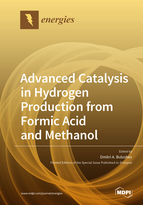Advanced Catalysis in Hydrogen Production from Formic Acid and Methanol
A special issue of Energies (ISSN 1996-1073). This special issue belongs to the section "A5: Hydrogen Energy".
Deadline for manuscript submissions: closed (31 March 2020) | Viewed by 24333
Special Issue Editor
Interests: catalysis; nanomaterials; hydrogen production; biomass conversion
Special Issues, Collections and Topics in MDPI journals
Special Issue Information
Dear colleagues,
Studies of catalytic decomposition of formic acid and methanol have more than 100 years of history, contributing significantly to the science and applications of catalysis. These studies are related to the name of Paul Sabatier, who was awarded the Nobel Prize in Chemistry in 1912. Formic acid and methanol contain a sufficient amount of hydrogen that can be liberated at mild conditions using catalysis. Formic acid and methanol are considered as liquid organic hydrogen carriers (LOHCs) and can be produced using renewable methods from biomass or by CO2 hydrogenation. Therefore, the studies in this field recently have become focused on the development of efficient catalysts for hydrogen production from these compounds.
The aim of this Special Issue is to discuss the field of hydrogen production by the catalytic decomposition (or steam-reforming) of formic acid and methanol. The questions of preparation and characterization of efficient homogeneous or heterogeneous catalysts, reaction mechanism and kinetics, reactor systems engineering, and catalyst design could be discussed in this issue. We invite researchers to submit their theoretical and/or experimental original results.
Dr. Dmitri A. Bulushev
Guest Editor
Manuscript Submission Information
Manuscripts should be submitted online at www.mdpi.com by registering and logging in to this website. Once you are registered, click here to go to the submission form. Manuscripts can be submitted until the deadline. All submissions that pass pre-check are peer-reviewed. Accepted papers will be published continuously in the journal (as soon as accepted) and will be listed together on the special issue website. Research articles, review articles as well as short communications are invited. For planned papers, a title and short abstract (about 100 words) can be sent to the Editorial Office for announcement on this website.
Submitted manuscripts should not have been published previously, nor be under consideration for publication elsewhere (except conference proceedings papers). All manuscripts are thoroughly refereed through a single-blind peer-review process. A guide for authors and other relevant information for submission of manuscripts is available on the Instructions for Authors page. Energies is an international peer-reviewed open access semimonthly journal published by MDPI.
Please visit the Instructions for Authors page before submitting a manuscript. The Article Processing Charge (APC) for publication in this open access journal is 2600 CHF (Swiss Francs). Submitted papers should be well formatted and use good English. Authors may use MDPI's English editing service prior to publication or during author revisions.
Keywords
- hydrogen
- formic acid
- methanol
- decomposition
- steam reforming
- supported catalysts
- metal complexes






